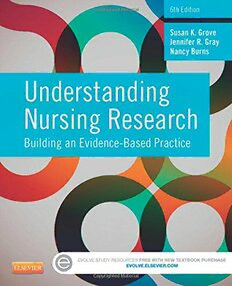Table Of ContentYOU’VE JUST PURCHASED
MORE THAN
A TEXTBOOK!
Evolve Student Resources for Grove:
Understanding Nursing Research: Building an
Evidence-Based Practice, 6th Edition, include
the following:
(cid:129) Review Questions
(cid:129) Research Article Library
(cid:129) Appraisal Exercises
(cid:129) Key Points
Activate the complete learning experience that comes with each
textbook purchase by registering at
http://evolve.elsevier.com/Grove/understanding/
REGISTER TODAY!
You can now purchase Elsevier products on Evolve!
Go to evolve.elsevier.com/html/shop-promo.html to search and browse for products.
CONTENTS
1
Introduction to Nursing Research
and Evidence-Based Practice, 1
2
Introduction to Quantitative Research, 31
3
Introduction to Qualitative Research, 66
4
Examining Ethics in Nursing Research, 93
5
Research Problems, Purposes, and Hypotheses, 129
6
Understanding and Critically Appraising
the Literature Review, 162
7
Understanding Theory and Research Frameworks, 189
8
Clarifying Quantitative Research Designs, 210
9
Examining Populations and Samples in Research, 248
10
Clarifying Measurement and Data Collection
in Quantitative Research, 281
11
Understanding Statistics in Research, 317
12
Critical Appraisal of Quantitative and Qualitative
Research for Nursing Practice, 361
13
Building an Evidence-Based Nursing Practice, 414
14
Outcomes Research, 466
Glossary, 500
Index, 515
This page intentionally left blank
6th Edition
Understanding
Nursing Research
Building an Evidence-Based Practice
Susan K. Grove, PhD, RN, ANP-BC, GNP-BC
Professor Emerita
College of Nursing
The University of Texas at Arlington
Arlington, Texas;
Adult Nurse Practitioner
Family Practice
Grand Prairie, Texas
Jennifer R. Gray, PhD, RN, FAAN
George W. and Hazel M. Jay Professor, College of Nursing
Associate Dean, College of Nursing
The University of Texas at Arlington
Arlington, Texas
Nancy Burns, PhD, RN, FCN, FAAN
Professor Emerita
College of Nursing
The University of Texas at Arlington
Arlington, Texas;
Faith Community Nurse
St. Matthew Cumberland Presbyterian Church
Burleson, Texas
3251RiverportLane
St.Louis,Missouri63043
UNDERSTANDINGNURSINGRESEARCH:BUILDING
ANEVIDENCE-BASEDPRACTICE,EDITIONSIX ISBN:978-1-4557-7060-1
Copyright©2015,2011,2007,2003,1999,1995bySaunders,animprintofElsevierInc.
Allrightsreserved.Nopartofthispublicationmaybereproducedortransmittedinanyformorbyanymeans,
electronicormechanical,includingphotocopying,recording,oranyinformationstorageandretrievalsystem,
withoutpermissioninwritingfromthepublisher.Detailsonhowtoseekpermission,furtherinformationaboutthe
Publisher’spermissionspoliciesandourarrangementswithorganizationssuchastheCopyrightClearance
CenterandtheCopyrightLicensingAgency,canbefoundatourwebsite:www.elsevier.com/permissions.
ThisbookandtheindividualcontributionscontainedinitareprotectedundercopyrightbythePublisher
(otherthanasmaybenotedherein).
Notices
Knowledgeandbestpracticeinthisfieldareconstantlychanging.Asnewresearchandexperiencebroadenour
understanding,changesinresearchmethods,professionalpractices,ormedicaltreatmentmaybecome
necessary.
Practitionersandresearchersmustalwaysrelyontheirownexperienceandknowledgeinevaluating
andusinganyinformation,methods,compounds,orexperimentsdescribedherein.Inusingsuch
informationormethodstheyshouldbemindfuloftheirownsafetyandthesafetyofothers,including
partiesforwhomtheyhaveaprofessionalresponsibility.
Withrespecttoanydrugorpharmaceuticalproductsidentified,readersareadvisedtocheckthe
mostcurrentinformationprovided(i)onproceduresfeaturedor(ii)bythemanufacturerofeachproducttobe
administered,toverifytherecommendeddoseorformula,themethodanddurationofadministration,and
contraindications.Itistheresponsibilityofpractitioners,relyingontheirownexperienceandknowledge
oftheirpatients,tomakediagnoses,todeterminedosagesandthebesttreatmentforeachindividualpatient,and
totakeallappropriatesafetyprecautions.
Tothefullestextentofthelaw,neitherthePublishernortheauthors,contributors,oreditors,assumeany
liabilityforanyinjuryand/ordamagetopersonsorpropertyasamatterofproductsliability,negligence
orotherwise,orfromanyuseoroperationofanymethods,products,instructions,orideascontainedin
thematerialherein.
InternationalStandardBookNumber:978-1-4557-7060-1
ExecutiveContentStrategist:LeeHenderson
ContentDevelopmentManager:BillieSharp
ContentDevelopmentSpecialist:CharleneKetchum
PublishingServicesManager:DeborahL.Vogel
ProjectManager:BridgetHealy
DesignDirection:MaggieReid
PrintedinChina
Lastdigitistheprintnumber: 9 8 7 6 5 4 3 2 1
CONTRIBUTOR AND
REVIEWERS
CONTRIBUTOR Tamara Kear, PhD, RN, CNS, CNN
AssistantProfessorof Nursing
DianeDoran,RN, PhD, FCAHS VillanovaUniversity
Professor Emerita Villanova,Pennsylvania
LawrenceS.Bloomberg Facultyof Nursing
Universityof Toronto SharonKitchie,PhD, RN
Toronto, Ontario AdjunctInstructor
Revised Chapter 14
Keuka College
Keuka Park, NewYork
REVIEWERS
Madelaine Lawrence,PhD, RN
Lisa D. Brodersen,EdD, MA, RN Associate Professor
Professor, Coordinatorof InstitutionalResearch Universityof NorthCarolina atWilmington
and Effectiveness Wilmington, NorthCarolina
Allen College
Waterloo, Iowa RobinMoyers, PhD, RN-BC
Nurse Educator
SaraL. Clutter,PhD, RN Carl Vinson VA Medical Center
Associate Professorof Nursing Dublin,Georgia
Waynesburg University
Waynesburg, Pennsylvania SueE. Odom,DSN, RN
Professorof Nursing
Clayton StateUniversity
JacalynP. Dougherty,PhD, RN
Morrow, Georgia
Nursing ResearchConsultant
JP DoughertyLLC
Teresa M.O’Neill, PhD, APRN, RNC
Aurora, Colorado
Professor
Our Ladyof HolyCrossCollege
JoanneT.Ehrmin, RN, COA-CNS, PhD,
New Orleans, Louisiana
MSN,BSN
Professor
Sandra L. Siedlecki, PhD, RN, CNS
Universityof Toledo, Collegeof Nursing
Senior Nurse Scientist
Toledo, Ohio
ClevelandClinic
Cleveland,Ohio
BetsyFrank,PhD, RN, ANEF
Professor Emerita SharonSouter, PhD,RN,CNE
Indiana State UniversityCollege ofNursing Dean andProfessor
Health,and Human Services Universityof Mary HardinBaylor
Terre Haute,Indiana Belton, Texas
v
vi CONTRIBUTOR AND REVIEWERS
Molly J.Walker, PhD,RN,CNS, CNE Fatma A.Youssef, RN, DNSc, MPH
Professor ProfessorEmerita
AngeloState University MarymountUniversity
San Angelo, Texas Schoolof HealthProfessions
Arlington, Virginia
CynthiaWard, DNP, RN-BC,CMSRN,
ACNS-BC
Surgical ClinicalNurse Specialist
Carilion RoanokeMemorialHospital
Roanoke, Virginia
AngelaWood, PhD,RN,Certified High-Risk
PrenatalNurse
Associate Professor and Chair
Department of Nursing
Carson-Newman University
Jefferson City, Tennessee
To all nurses who change the lives of patients through applying the best research evidence.
—Susan, Jennifer, and Nancy
To my husband Jay Suggs who has provided me endless love and support during my
development of research textbooks over the last 30 years.
—Susan
To my husband Randy Gray who is my love and my cheerleader.
—Jennifer
To my husband Jerry who has supported all of my academic endeavors
through 58 years of marriage.
—Nancy
PREFACE
Researchisamajorforceinnursing,andtheevidencegeneratedfromresearchisconstantlychang-
ing practice, education, and health policy. Our aim in developing this essentials research text,
Understanding Nursing Research: Building an Evidence-Based Practice, is to create an excitement
about research in undergraduate students. The text emphasizes the importance of
baccalaureate-educated nurses being able to read, critically appraise, and synthesize research so
this evidence can be used to make changes in practice. A major goal of professional nursing
andhealthcareisthedeliveryofevidence-basedcare.Bymakingnursingresearchanintegralpart
ofbaccalaureateeducation,wehopetofacilitatethemovementofresearchintothemainstreamof
nursing.Wealsohopethistextincreasesstudentawarenessoftheknowledgethathasbeengen-
eratedthroughnursingresearchandthatthisknowledgeisrelevanttotheirpractice.Onlythrough
researchcannursingtrulyberecognizedasaprofessionwithdocumentedeffectiveoutcomesfor
the patient, family, nurse provider, and healthcare system. Because of this expanded focus on
evidence-basedpractice(EBP),wehavesubtitledthiseditionBuildinganEvidence-BasedPractice.
DevelopingasixtheditionofUnderstandingNursingResearchhasprovideduswithanoppor-
tunity to clarify and refine the essential content for an undergraduate research text. The text is
designed to assist undergraduate students in overcoming the barriers they frequently encounter
in understanding the language used in nursing research. The revisions in this edition are based
on our own experiences with the text and input from dedicated reviewers, inquisitive students,
andsupportivefacultyfromacrossthecountrywhoprovideduswithmanyhelpfulsuggestions.
Chapter 1, Introduction to Nursing Research and Evidence-Based Practice, introduces the
reader to nursing research, the history of research, and the significance of research evidence for
nursingpractice.Thischapterhasbeenrevisedtoincludethemostrelevanttypesofresearchsyn-
thesisbeingconductedinnursing—systematicreview,meta-analysis,meta-synthesis,andmixed-
methods systematic review. The discussion of research methodologies and their importance in
generating an evidence-based practice for nursing has been updated and expanded to include
the exploratory-descriptive qualitative research method. A discussion of the Quality and Safety
EducationforNursing(QSEN)competenciesandtheirlinktoresearchhasbeenincludedinthis
edition.SelectedQSENcompetenciesarelinkedtothefindingsfromstudiespresentedasexamples
throughout thetext toincrease students’understanding ofthe importancein deliveringquality,
safe health caretopatientsand families.
Chapter2,IntroductiontoQuantitativeResearch,presentsthestepsofthequantitativeresearch
processinaconcise,clearmannerandintroducesstudentstothefocusandfindingsofquantitative
studies. Extensive, recentexamplesof descriptive, correlational, quasi-experimental, and experi-
mentalstudies areprovided, which reflect the qualityof currentnursing research.
Chapter 3, Introduction to Qualitative Research, describes five approaches to qualitative
researchandthephilosophiesuponwhichtheyarebased.Theseapproachesincludephenomenol-
ogy, grounded theory, ethnography, exploratory-descriptive qualitative, and historical research.
Data collection and analysis methods specific to qualitative research are discussed. Guidelines
forreadingandcriticallyappraisingqualitativestudiesareexplainedusingexamplesofpublished
studies.
viii

